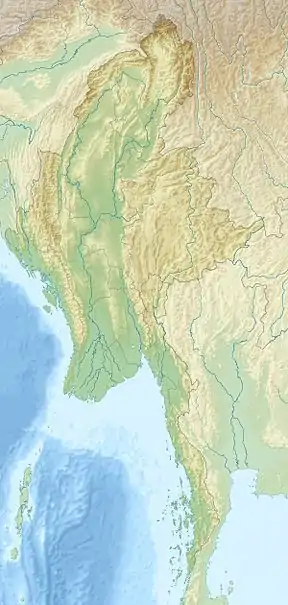Kahilu Wildlife Sanctuary
Kahilu Wildlife Sanctuary is a protected area in Myanmar's Kayin State. It was established in 1928 and covers 160.58 km2 (62.00 sq mi).[1] It is mostly flat with elevation ranging from 20 to 260 m (66 to 853 ft). Annual precipitation is about 3,800 mm (150 in).[2]
| Kahilu Wildlife Sanctuary | |
|---|---|
IUCN category IV (habitat/species management area) | |
 Kahilu Wildlife Sanctuary Location in Myanmar | |
| Location | Phapun Township and Paan Township, Kayin State, Myanmar |
| Nearest city | Sumprabom |
| Coordinates | 17°32′00″N 97°30′00″E |
| Area | 160.58 km2 (62.00 sq mi)[1] |
| Established | 1928 |
| Governing body | Ministry of Natural Resources and Environmental Conservation, Forest Department |
History
Kahilu Wildlife Sanctuary was established in 1928 for the protection of one of the last Javan rhinoceros (Rhinoceros sondaicus) families in the country.[3] As of 2011, it was not managed due to security issues.[2] The Forest Department is the responsible management authority.[4]
Biodiversity
Most of Kahilu Wildlife Sanctuary is covered by mixed deciduous forest, consisting of teak (Tectona grandis) and iron wood (Mesua ferrea) trees. Indian hog deer (Hyelaphus porcinus), lesser mouse-deer (Tragulus kanchil) and serow (Capricornis milneedwardsii) live in this protected area. Bird species include jungle fowl, hornbill, myna, parakeets, doves, partridge, lapwing, drongos, kite and owl.[2]
Threats
Kahilu Wildlife Sanctuary is threatened by shifting cultivation practices, collection of non-timber forest products and hunting of wildlife. It will likely be flooded if a planned dam is constructed near the confluence of Salween and Moei Rivers.[2]
References
- World Database on Protected Areas (2019). "Kahilu Wildlife Sanctuary". Protected Planet.
- Beffasti, L.; Gallanti, V., eds. (2011). "Kahilu". Myanmar Protected Areas: Context, Current Status and Challenges (PDF). Milano, Yangon: Istituto Oikos, Biodiversity and Nature Conservation Association. pp. 40–41.
- Smith, H. C. (1935). "Wild Life Protection in Burma". Journal of the Bombay Natural History Society. 37 (Supplement: The Wild Animals of the Indian Empire and the Problem of their Preservation, Part III): 167–188.
- Lazarus, K. M.; Cardinale, P.; Corbett, M.; Lin, N. S.; Noeske, T. K. H. (2017). "Baseline Assessment Report of Terrestrial Biodiversity" (PDF). Strategic Environmental Assessment of the Hydropower Sector in Myanmar. Washington, D.C.: International Finance Corporation.